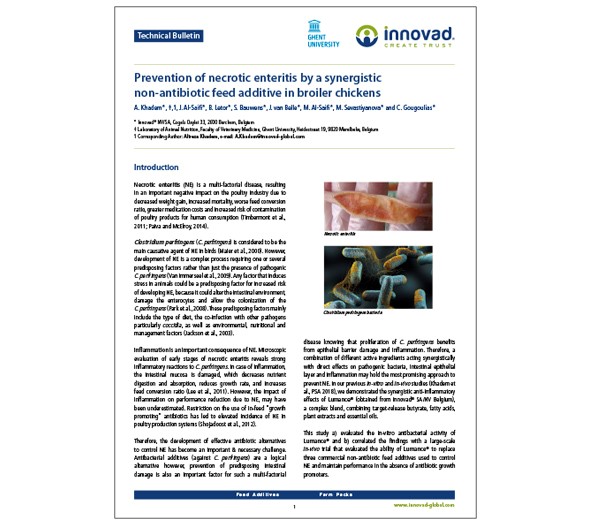Lumance®
Intestinal health solution to lower medication and improve performance
Gut Health
Intestinal health is the most determining factor for animal health in general, herd performance and eventually farm profitability. Pathogenic bacteria may colonise the gastrointestinal tract and result in clinical and sub-clinical disease. Reduced feed intake and daily gain, inactivity and decreased social interactions are all observed in animals with bacterial infections.
Livestock producers are often forced to make use of unconventional protein and carbohydrate sources or materials of lower quality. This means that animals are constantly challenged with changing diet compositions and quality, which cause risks for their health.
Stress often leads to health challenges and intestinal disorders and is linked with the ‘leaking gut’ syndrome. The end-product is subclinical inflammation which can cost up to 30% of the animal’s energy requirements.
Regulation, food safety and animal welfare are also setting up new trends towards limitations or restrictions of antibiotic usage for disease treatment, medicated feed, zinc oxide etc.
By controlling the microflora in the lumen and strengthening the intestinal epithelium integrity, Lumance® offers a comprehensive gut health management program that aims at reducing medication or cocktails of medication.
Lumance® is a cutting-edge formulation featuring advanced matrix protection and slow-release technologies. Our innovative approach ensures that the active ingredients are delivered effectively to the intestinal tract in a gut-active manner, providing robust and efficient support for intestinal health. Lumance® also supports the enhancement of tight junction integrity, the neutralization of reactive oxygen species (ROS), and the modulation of inflammatory cytokine production. Additionally, it includes functional ingredients and anti-caking agent for optimal stability and performance.
Experience the powerful benefits of Lumance® for comprehensive gut health.

Modes of Action
1. Reinforce gut integrity
- Stimulates the growth of villi
- Reinforces the intestinal defense
- Enhances the intestinal barrier
2. Reduce inflammatory response
The anti-inflammatory properties of butyric acid are complemented by plant extracts rich in alkaloids and essential oils found in the unique Lumance® recipe. Their efficacy and synergistic effect were demonstrated both in vitro and in vivo.

a) In vitro inhibition of LPS induced inflammation in macrophage producing cell lines by Lumance® expressed as reduction of Nitric Oxide,
b) Demonstration of the synergistic effect of Lumance®
c) In vivo demonstration of the anti-inflammatory effect of Lumance® (gene expression of the chicken Host Defense Peptide, β-defensin 9 - AvBD9)
3. Balance the lumen and its gastrointestinal microflora
Lumance® has been carefully designed to reduce the impact of pathogens and support the growth of beneficial bacteria. The graph below shows the direct antibacterial effect of Lumance in vitro against a) Clostridium perfringens and b) Salmonella Typhimurium
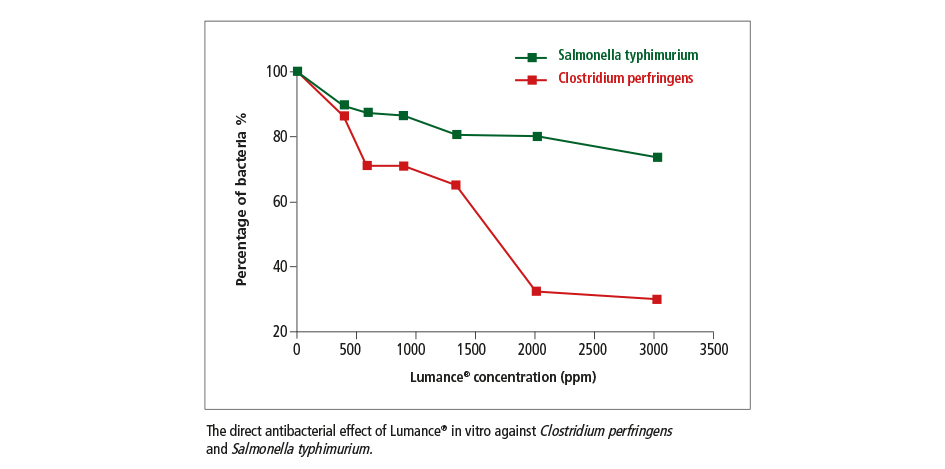
4. Protect against ROS
Butyrate along with the plant extracts and essential oils added in Lumance® have been selected for their antioxidant activity and oxidative stress inhibitory effect.
Product composition and positioning may vary by market based on the regulatory status.
The Synergistic effect of Lumance®
It is critical to develop cost effective antibiotic alternative strategies to ensure the long-term sustainability of animal production. Dr. Alireza Khadem, Research & Technical Manager Poultry at Innovad and PhD researcher at the University of Ghent tested the anti-inflammatory activity of Lumance® and the effect of its three main ingredients (fatty acids, essential oils and plant extracts) individually.

Better performance through a synergistic combined approach in broilers raised without antibiotics
Innovad evaluated the in-vitro antibacterial activity of Lumance®. We then correlated the findings with a large-scale in-vivo trial which evaluated the ability of Lumance® to replace three different commercial feed additive products that were applied simultaneously to control Necrotic Enteritis in order to maintain performance, in the absence of antibiotic growth promoters.
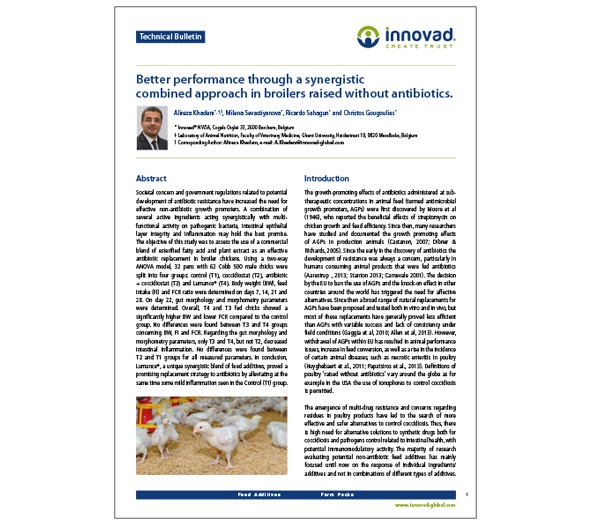
Colibacillosis in layers
Colibacillosis, a syndrome caused by E. coli, is one of the most common infectious bacterial diseases of the layer industry. Inflammation resulting from either feed or disease is inversely related to growth and health. This echnical Bulletin contains more information on this subject and a study performed with the University of Ghent on the anti-inflammatory effects of Lumance®.
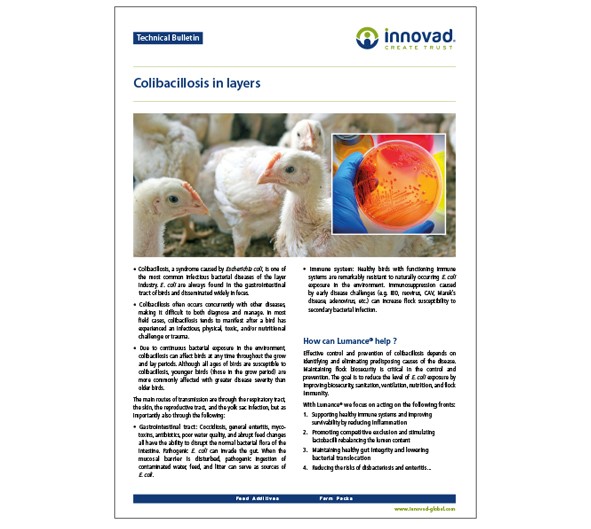
Lumance® enhances the intestinal barrier function and ameliorates barrier disruption
Stressors like pathogens and toxins increase the gut permeability leading often to chronic inflammation and disease such as Necrotic Enteritis. Deoxynivalenol (DON) increases the gut permeability and predisposes for Clostridium perfringens induced Necrotic Enteritis in broiler chickens. In other
words, DON can replace coccidiosis (Eimeria) as a predisposing factor for NE. Transepithelial electrical resistance (TEER) is a widely accepted technique to measure the integrity of tight junction dynamics in cell culture models and the IPECJ-2 cell line is a well-established model for
studying intestinal barrier functions. This article demonstrates that Lumance® enhances significantly the tight junctions even under bacterial enterotoxin (LPS) challenge in IPECJ-2 cell.
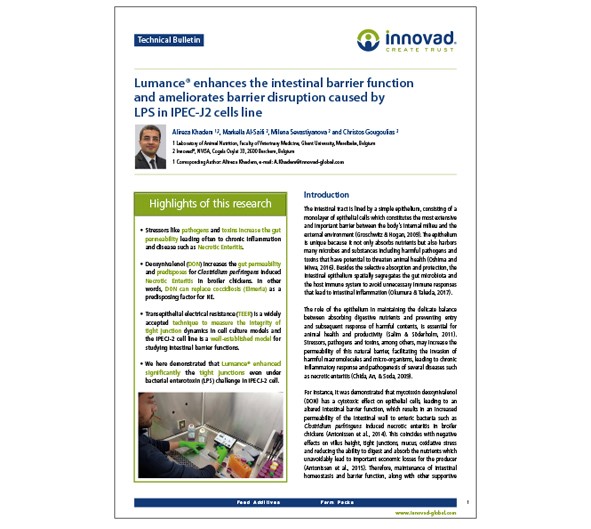
Prevention of necrotic enteritis in broiler chickens
Necrotic enteritis (NE) is a multi-factorial disease, resulting in an important negative impact on the poultry industry due to decreased weight gain, increased mortality, worse feed conversion ratio, greater medication costs and increased risk of contamination of poultry products for human consumption. This study a) evaluated the in-vitro antibacterial activity of Lumance® and b) correlated the findings with a large-scale
in-vivo trial that evaluated the ability of Lumance® to replace three commercial non-antibiotic feed additives used to control NE and maintain performance in the absence of antibiotic growth promoters.
